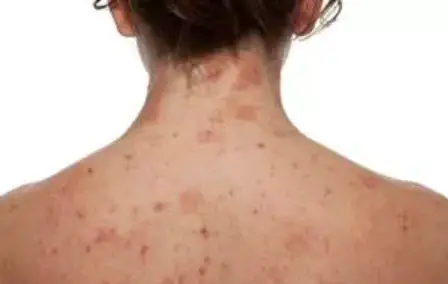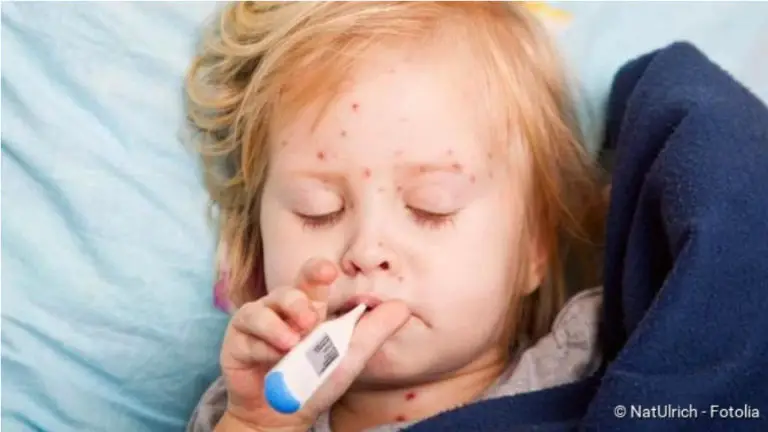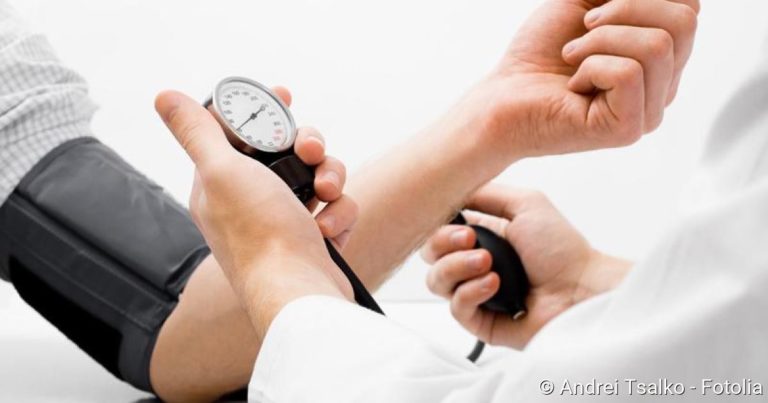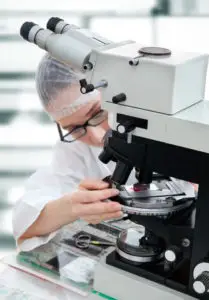HPV: causes, secondary diseases, symptoms, treatment
HPV: causes, secondary diseases, symptoms, treatment
The abbreviation HPV stands for Human Papillomavirus. The pathogen causes venereal diseases and can manifest itself through warts on the skin and genital area. Most HPV infections heal unnoticed, but malignant tumours can still develop long after infection. Both men and women can be infected with HPV. Read more about HPV here.
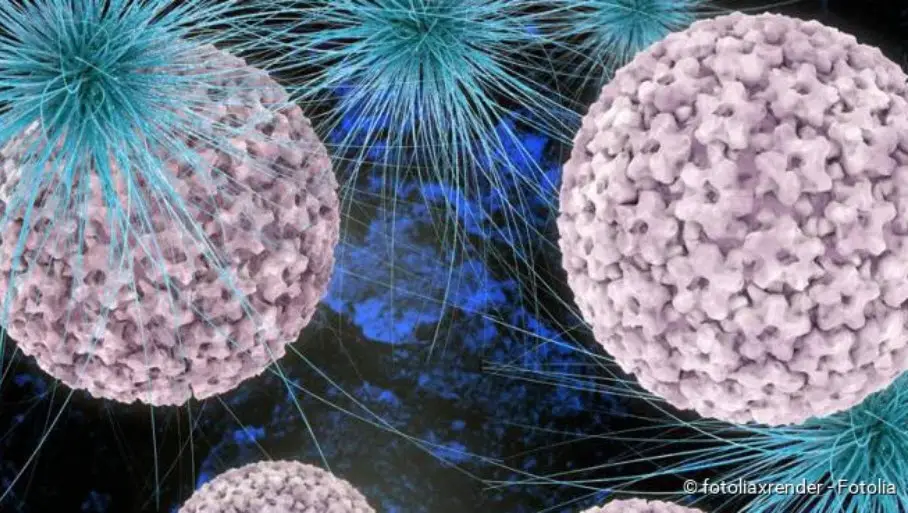
HPV: Short overview
- Infection: mainly via direct contact with the skin or mucous membrane (sexual intercourse); virus transmission is also possible via infected objects (sex toys, towels, etc.) and at birth (from the infected mother to the child)
- Secondary diseases: Depending on the HPV type, mainly skin warts, genital warts (genital warts), tissue changes (potential precancerous lesions) and cancer (such as cervical cancer, mouth and throat cancer, anal cancer)
- Common symptoms: depending on the clinical picture; e.g. in the case of genital warts, reddish, brownish or whitish papules in the genital and anal region, possibly with a feeling of wetness and itching; in the case of cervical cancer, vaginal discharge and unexplained vaginal bleeding
- Important research: Physical examination, cell smear, colposcopy (in women), HPV test, biopsy (analysis of a tissue sample)
- Treatment: Depending on the clinical picture icing, laser therapy, electrocautery, medication, surgical interventions
HPV: causes and risk factors
Human papillomaviruses (HPV) belong to the group of DNA viruses. Like the human genome, your genetic information is stored on a DNA strand. HPV viruses require human cells to multiply. The infection works like this:
HPV viruses introduce their genetic material into a human host cell (skin or mucous membrane cell) and force it to constantly produce new viruses. At some point, the host cell bursts open (and dies in the process), releasing the many new viruses. They can then in turn attack new human cells.
Life cycle of HP viruses:

HPV transmission
Many HPV viruses are transmitted by mere skin contact. This is especially true for those pathogens that cause harmless skin warts (papillomas).
HPV types that infect the genitals and cause genital warts or cervical cancer, for example, are mainly transmitted through sexual intercourse. Genital HPV infections are therefore considered sexually transmitted diseases (STD). HPV virus transmission is also possible through oral sex if the oral mucosa comes into contact with HPV-infected skin areas (such as labia or penis). The same applies to physical contact when bathing together, although this is a much rarer route of infection.
At least theoretically, HPV virus infection is also possible via infected objects such as sex toys, towels or the toilet.
Another possibility is the transmission of the pathogen from mother to child during birth.
According to current knowledge, there is no risk of infection from breastfeeding, normal kissing or blood donation.
If genital anal warts can be found in the genital anus area of children, special attention is required. Here, each individual case must be examined and sexual abuse must be excluded.
Not all HP viruses are dangerous. But those that are, namely the so-called high-risk HP virus strains, are particularly aggressive and can cause malignant changes such as cervical cancer, penis and anal carcinoma and ENT tumours. In this respect, it makes sense to protect oneself against it wherever possible.
Since HP viruses are primarily transmitted via sexual contacts, one should protect oneself with condoms in new partnerships. Although these do not provide 100 percent protection against infection, they do provide extensive protection. In addition, PAP smears from the cervix and an HPV test help to keep an eye on your own risk situation. In advance, before the first sexual contacts, a vaccination protects.
HPV vaccination for young girls in puberty and more recently also for boys makes sense because it protects against nine HPV types that are classified as highrisk. Thus, appropriately vaccinated children have a high protection against malignant changes that can be triggered by aggressive HP viruses.
Risk factors
Probably the most significant risk factor of genital infection results from the mechanism of HPV transmission: frequent and above all unprotected sexual intercourse. Other risk factors for HPV infection are
- first sexual contacts before the age of 16: This risk factor is particularly true for girls.
- Smoking: Cigarettes and tobacco in general. not only increase the risk of HPV infection, but also the risk that the cells degenerate and develop into cancer cells.
- Births at a young age and several children: During pregnancy the mucous membrane at the cervix changes and becomes more susceptible to infections. The tissue changes can persist for several years after pregnancy.
- inconsistent use of condoms: condoms cannot prevent HPV infection 100 percent. However, if they are used consistently in sexual contacts, the risk of infection is reduced.
- suppressed immune system: If the immune system is impaired in its function due to a disease (such as HIV) or by medication (immunosuppressants), the risk of HPV infection increases.
- other genital infections such as chlamydia or genital herpes: they also appear to promote HPV transmission.
In addition, some factors increase the risk of HPV-infected cells becoming cancer cells. These include smoking, many pregnancies, HIV infection and taking the contraceptive pill for five years or longer.
HPV: secondary diseases
The secondary diseases that can result from an HPV infection depend on the type of virus. So far, more than 200 different HPV types are known. Most of them cause no symptoms at all or only harmless skin warts. About 40 HPV types specifically infect the genital mucous membrane. They are divided into groups according to how likely they are to cause cancer:
Low-risk types (low-risk HPV) hardly cause dangerous genital warts (genital warts) when infected. Although there is also a cancer risk here, this is very low (low risk). The most common low-risk types are HPV 6 and 11, and other known representatives of this group are HPV 40, 42, 43, 44, 54, 61, 62, 70, 71, 72, 74, 81 and 83.
High-risk types (high-risk HPV) trigger tissue changes (dysplasia, neoplasia) from which a malignant tumour can develop over the years, especially cervical cancer. HPV infection can also increase the risk of other cancers such as penis cancer or cancer of the throat. The two main high-risk HPV types are HPV 16 and 18, and also include HPV viruses 31, 33, 35, 39, 45, 51, 52, 56, 58, 59 (and possibly others).
Some papillomaviruses such as HPV 26, 53 and 66 are more likely to be detected in precancerous stages. Some authors refer to this as intermediate HPV. The cancer risk for these HPV types lies between that of the low and high-risk types. For example, HPV viruses 5 and 8 are also classified as intermediate HPV. They are actually only really dangerous in cases of immune deficiency and epidermodysplasia verruciformis. The latter is a rare hereditary skin disease.
Genital warts (Condylomata acuminata)
Genital warts (pointed condylomas) are benign tissue growths in the genital area and anus. They are transmitted through unprotected sexual intercourse and are usually triggered by the low-risk types HPV 6 and 11, but sometimes also by other representatives of HPV. Men and women can fall ill with it.
It can take up to eight months from infection with the HPV virus until the genital warts appear (incubation period). Condylomas are the most common benign tumors of the external genital and anal area. They can heal spontaneously, but can also persist for months or years.
Plana condylomata
Condylomata plana are flat wart variants of genital warts on the outer and inner genitals. The HPV viruses 16, 18, 31 and 33 are considered to be the main causative agents and can lead to cell changes, which are known as intraepithelial neoplasias. These cell changes are considered to be potential precursors of cancer and are classified according to where they occur:
- Cervical intraepithelial neoplasia (CIN): at the cervix (cervix = cervix)
- Vulval intraepithelial neoplasia (VIN): on the vulva (= labia, clitoris and mons pubis)
- Vaginal intraepithelial neoplasia (VAIN): in the vagina (vagina)
- Penile intraepithelial neoplasia (PIN): on the penis
- Perianal intraepithelial neoplasia (PAIN): in the anal region
- Anal intraepithelial neoplasia (AIN): in the anus
If you would like to know more about the development and treatment of condylomas, read the article on condylomas.
Cervical cancer (cervical carcinoma)
If mucous membrane cells at the cervix are chronically infected with high-risk HPV types, they can degenerate over time and form a malignant tumour. However, this does not happen with every infection, but relatively rarely: Statistics show that less than one in 100 women infected with a high-risk HPV type develops cervical cancer – on average 15 years after HPV infection.
It therefore takes quite a long time for the malignant tumour to develop. Women should therefore go to the gynaecologist for regular check-ups once a year: The so-called Pap smear from the cervix can reveal suspicious cell changes early on.
You can read more about the development, symptoms, treatment and prognosis of cervical cancer in the text Cervical cancer.
Other cancers
In cervical cancer, the link with the HPV virus has been clearly proven. However, the development of cancer through HPV is also being investigated in other areas. Oral sex, for example, can increase the risk of malignant growths in the throat and pharynx area (such as laryngeal cancer). Cancerous growths in the genital and anal areas such as vaginal cancer, vulvar cancer, penis and anal cancer can also be favoured by infection with high-risk HPV types. However, all these forms of cancer are much rarer than cervical cancer.
Skin warts
Some HPV viruses cause common skin warts called verrucae vulgares. They are the most common type of warts. There are various special forms of it, such as the butcher’s wart. It occurs when working in a damp and cold environment with raw meat (i.e. mainly in butchers) and is associated with HPV virus type 7.
If an infection with HPV causes warts on the sole of the foot, these are usually plantar warts (verrucae plantares). The trigger is usually HPV 1; if a large number of plantar warts occur in the form of wart fields, dermatologists refer to them as mosaic warts.
The flat warts often seen in children are caused by HPV 3 or 10. Their technical name is Verrucae planae juveniles.
Warts in the mouth
Sometimes single warts form in the mouth. They are called oral papilloma. In some of them a connection with HPV infection can be proven.
If warts or wart-like formations appear in the mouth, it can also be Heck’s disease (Heck’s disease or focal epithelial hyperplasia). These benign skin growths always occur in clusters and not individually. Its development is related to HPV 13 or 32, and Heck’s disease is rare among the United States and European population, but is more common in other populations, for example among the indigenous peoples of Central and South America.
Verruciform epidermodysplasia
This rare disease is a chronic HPV infection of the skin. According to its discoverers, it is also known as Lewandowsky-Lutz syndrome. It occurs in large numbers in families and is a hereditary skin disease. Due to a genetic defect, the HPV viruses can spread more easily among those affected. Various HPV types play a role in the development of epidermodysplasia verruciformis, including HPV 3, 5, 8 and 10.
HPV: signs (symptoms)
In many cases, the human immune system can fight HPV viruses quite well, so that no or hardly any HPV symptoms occur. In the case of a latent HPV infection, human papilloma viruses can only be detected in the laboratory. In a subclinical HPV infection, the virus-related skin/mucosal changes can only be visualized using special techniques.
If, on the other hand, HPV symptoms visible to the naked eye occur, doctors speak of a clinical HPV infection. Which signs HPV viruses trigger depends on the virus type and the respective disease.
Symptoms of genital warts (Condylomata acuminata)
Genital warts or pointed condylomas can develop three to eight weeks (incubation period) after infection with certain HPV viruses. These are reddish, grey-brownish or whitish papules of the skin or mucous membrane of the genital and anal region. Their size varies between the size of a pinhead and several centimetres. The individual condylomas often lie close together and form so-called papilloma beds.
In women, such HPV signs are mainly found in the area of the labia, at the posterior junction of the two labia majora (posterior commissure) and in the anal region. Genital warts can also develop in the vagina and at the cervix. In men, these signs of HPV infection affect the penis and anal region.
Genital warts hardly cause any complaints. Sometimes, however, wetness and itching, burning and bleeding after intercourse are possible symptoms of HPV-induced genital warts. Pain, on the other hand, is indicated only occasionally.
In rare cases, genital warts that have existed for years develop into so-called Buschke-Löwenstein giant condylomas (Condylomata gigantea). These cauliflower-like growths displace and destroy the surrounding tissue. The cells can degenerate and become cancer cells (verrucous carcinoma).
Symptoms with Condylomata plana
Those affected develop inconspicuous, flat raised thickenings (warts) on the external genitals, in the anal canal and (in women) in the vagina and cervix. The warts usually occur in larger numbers and are grey-white to reddish in colour (like the mucous membrane).
Symptoms of intraepithelial neoplasia
In many patients, intraepithelial neoplasia does not cause symptoms. This applies, for example, to cervical intraepithelial neoplasia (CIN). In other cases, more or less obvious complaints may arise. For example, intraepithelial neoplasia in the area of the vulva (VIN) can be accompanied by itching, burning and pain during sexual intercourse (dyspareunia), but can also be asymptomatic. An anal or perianal intraepithelial neoplasia (AIN and PAIN) causes itching in the anal region as well as discrete bleeding from the anus and pain during bowel movements. Cellular changes in the penis (PIN) can cause a velvety, irregular, shiny redness in the area of the glans or foreskin.
Symptoms of HPV-associated cancer
The most common cancer in which HPV viruses are involved is cervical cancer. Most affected women show no symptoms in the early stages of the disease. In other women, vaginal discharge and bleeding after intercourse, between menstrual bleeding or after menopause indicate a possible tumor disease. However, these symptoms can also have other causes.
In advanced stages of cervical cancer, women often report pain in the lower back or pelvic area, when urinating or defecating. Lymphostasis in the legs can also occur.
Sometimes other cancers are also associated with HPV. Symptoms depend on the location of the tumor and the stage of the disease. In the case of penis cancer, for example, skin changes such as swelling or hardening of the glans or foreskin, light bleeding of the skin on the penis and sometimes a foul-smelling discharge can occur. Vaginal cancer only becomes noticeable at an advanced stage with symptoms such as bloody discharge or vaginal bleeding (for example after sex).
Symptoms of skin warts
Skin warts are usually easy to detect. As a rule, they do not cause any discomfort, apart from the occasional itching, feeling of pressure or tension. Warts on the sole of the foot can also cause pain. Sometimes warts (like plantar warts) have small black spots. It is coagulated blood from tiny skin capillaries.
Common verrucae are pinhead to pea-sized and have a rough, scaly surface. They form preferentially on the back of the hand, on the fingers and nail edges as well as on the feet.
Plantar warts on the soles of the feet are pressed inwards like nails by body weight when walking or standing. This can cause such pain that the affected person can hardly walk.
Mosaic warts are about the size of a pinhead and white. They grow especially on the balls of the feet or under the toes. In some patients they also cover the entire underside of the foot. Because they are flatter than plantar warts, they usually do not cause pain when walking or standing.
Verrucae planae juveniles, which occur mainly in children, are flat, skin-coloured warts. They form especially on the face and the backs of the hands. If children scratch it, they spread the HPV viruses in a line pattern, so that the warts are often also arranged in lines.
Symptoms of warts in the mouth
Oral papillomas are individually occurring, cauliflower-like wart formations in the mouth. They are preferably found on the hard or soft palate or the uvula.
In Heck’s disease, several round or oval papules develop on the oral mucosa. Children and young people are particularly affected.
Symptoms of epidermodysplasia verruciformis
In this disease, generalized, i.e. all over the body, an abnormal number of skin lesions are formed, which resemble flat, irregular warts (verrucosis). The slightly scaly papules or plaques are reddish to brownish in colour. Affected are mainly young people, less often older adults. The risk of developing skin cancer is significantly increased, especially in open skin regions exposed to the sun.
HPV: diagnosis and examination
In most cases, no HPV symptoms are found in an infection. For the most part, an infection remains unnoticed. However, if the HPV viruses trigger signs of disease, these are usually typical changes in the skin or mucous membrane. However, some manifestations are so inconspicuous that they can only be made visible by special procedures. The necessary examinations are usually carried out by specialists, i.e. depending on the clinical picture either dermatologists, gynaecologists, urologists or ear, nose and throat specialists.
Medical history (anamnesis)
First, the doctor asks the patient about any symptoms that might be related to HPV infection, for example:
- Where exactly are the complaints or skin changes?
- Is there genital itching or burning?
- Has there been any unexplained bleeding?
Since sexual activity plays a crucial role in HPV, the doctor will also formulate specific questions about this: Has the sexual partner been changed frequently? Have you noticed any changes in the mucous membranes, possibly noticeable warts?
General risk factors such as smoking or medication are also noted. The doctor also asks about known previous illnesses. These may weaken the immune system and thus promote HPV infection.
Physical examination
The doctor usually examines the whole body. Most HPV symptoms, namely warts on the skin, are easily recognized. Further examinations are then usually not necessary. If a skin wart appears suspicious, the doctor removes it and sends it to a laboratory for further examination.
Changes in the female genital area are usually discovered during preventive examinations. The vagina is scanned and then examined with a speculum (“mirror”). Blanking is important, because sometimes specula cover deep-seated growths, as they can be triggered by HPV viruses.
HPV-suspicious manifestations in the male genital area are usually visible to the naked eye and unambiguous. The specialist for this region of the body, the urologist, mainly examines the glans of the penis, the urethral outlet (external urethra) and its dilation (navicular fossa). Under certain circumstances, he may spread this area open in order to be able to examine the last two centimetres of the urethra.
HPV can also be found in the anal region. Since HPV can cause tumours that extend into the anal canal, some doctors perform a mirror image of the anal canal (proctoscopy).
Cell smear
For women aged 20 and over, gynaecologists regularly take a smear test of the cervix for early detection of cervical cancer. The surface of the uterine orifice is first wiped with a kind of brush by circular movements. The doctor takes the second smear from the cervical canal. The smears are then consolidated on a glass plate using a high-proof alcohol solution, then coloured and examined. This is not a special HPV smear to detect the viruses, but rather an examination for suspicious cell changes that may result from HPV infection (or from other reasons).
A scale developed by the Greek physician Georges Papanicolaou is used to assess possible cell changes. That is why this examination is also called Pap test.
Colposcopy
Colposcopy is to be understood as an extended reflection of the vagina. For this examination the gynaecologist also uses a so-called colposcope (colpo = vagina; scopie = observation), i.e. a kind of microscope. With up to 40x magnification, the doctor can thus detect even the smallest changes or bleeding at the cervix, cervix, vaginal walls and vulva. In extended colposcopy, the doctor dabs two to three percent acetic acid onto the mucous membrane. Altered upper surface layers swell up as a result and lift off whitishly from the remaining mucosa.
A further step is the so-called Schiller iodine test. The vaginal mucosa is dabbed with an iodine solution (four percent Lugol iodine solution). The healthy mucous membrane then turns brown-red due to the starch (glycogen) it contains. In contrast, cell layers that are altered by HPV, for example, remain unstained.
Biopsy
If the doctor discovers abnormalities during the smear test or colposcopy, he can specifically remove tissue from the female genital area and examine it (biopsy). Depending on the location of the diseased mucosa, the tissue sample is scraped out with a sharp spoon (curettage) or a cone is cut out of the vaginal tissue (conisation).
HPV test
This test is used to detect HPV infection and identify the virus type. Its use at the cervix is best tested: the test result helps to diagnose the malignant tumour or its precursors. The test is much less suitable for detecting HPV infection in other parts of the body.
The HPV test is available in different variants. For the early detection of cervical cancer, it is currently only recommended for women aged 30 and older together with the Pap test. If a conspicuous Pap test is already present at a younger age, a test for human papillomaviruses can also be useful. It can also help to control the success of therapy after treatment of precancerous lesions of the cervix.
If you would like to know more about the procedure, significance and costs of this examination, please read the article HPV test.
HPV: treatment
In most cases, HPV infections heal spontaneously because the immune cells kill the HPV viruses. However, sometimes existing diseases weaken the immune system and thus the fight against HPV. It is therefore necessary to address them.
In general, the choice of HPV therapy depends on the type and extent of HPV symptoms. Disease symptoms such as condylomas or skin warts can be treated in different ways. The HPV viruses themselves are rarely completely eliminated. This is why relapses are frequent.
Icing (cryotherapy)
This HPV treatment option is used for superficial condylomas and skin warts. The doctor applies liquid nitrogen to the affected area of skin with the help of a spray or with a stick (cotton wool, metal), which causes the tissue to die. Sometimes a small bubble forms. The application is usually repeated every one to two weeks. However, the HPV virus survives this procedure. In many cases, new warts therefore form as a result.
Electrocauter
This treatment is also carried out by a doctor. Like icing, electrocautery can be used for condylomas and warts of the skin. The tissue altered by HPV is destroyed by electric current. However, the HPV virus remains in the body and can trigger new skin changes at any time.
The electrocauter is also used after surgical removal of warts: The directly adjacent skin layers and their vessels are charred. Although this reduces the risk of relapse, a scar is very likely to form.
Operational procedures
Any HPV symptom can also be treated surgically. Various instruments can be used for this purpose. First the affected body region is locally anaesthetised. Then the growths can be cut out (excision) with a sharp spoon (curettage), an electrosurgical loop (loop electrosurgical excisional procedure, LEEP) or surgical scissors (scissor strike).
In suspicious neoplasms (intraepithelial neoplasia, especially cervical) of the genital mucosa, often a whole cone is cut out (conisation). However, several follow-up checks are usually carried out beforehand: Every six months the doctor checks how the clinical picture changes. If the conspicuous area becomes enlarged and high-risk HPV has also been detected, the tissue must be removed. If the tumour has already been identified as malignant, surgery is performed as soon as possible. However, if the patient is pregnant, an attempt is made to delay the operation until after the birth. Depending on the stage of cancer, the surgeon will extend the procedure accordingly. For example, in the case of advanced cervical carcinoma, the entire uterus is removed (radical hysterectomy).
For some cancer patients, radiotherapy and/or chemotherapy is used as an alternative or complementary treatment to surgery.
Laser therapy
This possibility of treating HPV diseases is also one of the surgical procedures. The laser (for example CO2 or Nd:YAG laser) is used for HPV warts of all kinds. Under local anesthesia the growths are cut out and vaporized. However, caution is advised: The HPV viruses can easily spread through the smoke. For this reason, adequate protection by exhausters and filters is particularly important.
Medicines against HPV warts
There are some drugs for the treatment of HPV warts in the genital or anal area. Some are administered by a doctor, others can be used by patients at home to treat HPV symptoms. Careful and regular use of the medication is crucial for the success of the therapy. Examples:
| Drug | User | Notes |
| Podophyllotoxin 0.15% cream | Patient |
|
| Imiquimod-5% cream | Patient |
|
| Trichloroacetic acid | Doctor |
|
In principle, HPV infections carry a high risk of relapses (recurrence). Therefore, the treated areas should be carefully checked and the doctor should be consulted at regular intervals.
HPV: course of disease and prognosis
The classic course of an HPV infection does not exist. It often goes unnoticed and heals without consequences. If HPV symptoms occur, spontaneous healing is also possible. In general, most HPV infections heal within a few months. After two years, about 90 percent of all HPV infections are cured.
Only in a few patients do certain HPV viruses last longer and even lead to cancer. This can still happen years or decades after HPV infection.
A healed HPV infection offers no protection against a renewed infection with the pathogens.
HPV: Prevention
There is much discussion about how to protect oneself from HPV infection. Prevention is not easy because HPV viruses are widespread and the risk of infection is therefore very high.
In general, it makes sense to pay attention to thorough hygiene and strengthen the immune system. To reduce the risk of infection with normal skin warts, you should also avoid walking around barefoot in swimming pools, saunas, public changing rooms and hotel rooms. If someone around you has warts, you should not share a towel, washcloth or socks (on your feet if you have warts) with that person.
To prevent HPV infections in the genital and anal areas, a condom should always be used, especially if the sex partners change frequently. Safer Sex does not offer reliable protection against HPV, because the HPV virus can be transmitted by smear infection. However, condoms can reduce the risk of infection.
It is considered certain that the risk of HPV is lower in men who are circumcised than in those who are not.
HPV: Vaccination
The Standing Vaccination Commission (STIKO) of the Robert Koch Institute recommends that all girls and boys between the ages of nine and fourteen years be recommended against HPV (preferably before first sexual intercourse). Those who are still unvaccinated at the age of 15 should catch up on the vaccination by their 18th birthday at the latest.
HPV vaccination is primarily used to reduce the risk of cervical cancer. It can also reduce the risk of some other types of cancer (vaginal cancer, penis cancer, etc.) and prevent the development of genital warts (genital warts) in both sexes.
How long the vaccination protection lasts is not yet known exactly. Study results indicate that vaccinated girls/women are still effectively protected against HPV infection 12 years after vaccination. However, it is not yet possible to say whether the vaccination protection should not be refreshed at some point.
You can read more about the implementation, effectiveness and costs of this vaccination against HPV in the article HPV vaccination.
